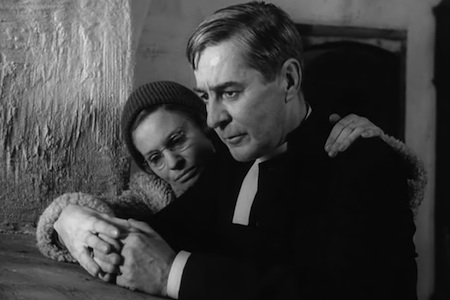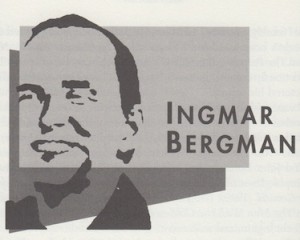Born: July 14, 1918, Uppsala, Sweden
Died: July 30, 2007, Fårö, Sweden
For Bergman, to be alone means to ask questions. And to make films means to answer them. Nothing could be more classically romantic.
—Jean-Luc Godard
The magical films of director Ingmar Bergman are purely autobiographical. Woven from strands of family, love, tragedy and death, his body of work represents a completed tapestry of a single life. No other filmmaker has come closer than Bergman to articulating personal fears and dreams through compelling storytelling devices. His use of huddled spaces, visual metaphors, flashbacks and rhythmic dance created the language of feelings. Focusing on the exploration of the self, his ideas meshed easily with Freudian psychoanalytical thinking, and college students studying his films found ways to express their own inner emotions.
Bergman made tremendous strides in modernizing cinema in the 1950s. After entering the Swedish film community as a screenwriter for director Alf Sjoberg, Bergman was assigned to direct his own films and released The Devil’s Wanton (1949). Already present in his stories was the strong use of religious symbols and a preoccupation with death. This fatalism, which stemmed from a deeply troubled childhood, became at first a thread throughout his films, then a stigma as many fans playfully joked about the depressing nature of his themes.
His next films, Summer Interlude (1951) and Summer with Monika (1953), revolved around feelings of ill-fated love that reflected Bergman’s eternal questions about marriage, a theme he would return to time and time again. These early films established strong roles for women. In Interlude, a restless ballerina reexamines a first love as a means of infusing her career with new enthusiasm. The wit and energy reflected by the females are set against the lethargy and cynicism of their male counterparts.
His Sawdust and Tinsel (1953), in which traveling circus performers stumble through poor villages in nineteenth-century Sweden, saw the beginning of a visual approach that strongly marked his later films. He used ancient settings to explore classical themes, but with a modern theatrical feel reminiscent of experimental stage plays. Beautiful black-and-white photography echoes the past, but the striking costumes and contrasting makeup give the characters the stylized appearance of kabuki players. This allowed Bergman to express his thoughts on jealousy, despair and sexuality through metaphors. The culmination of his newfound style and age-old ethics was a medieval morality play, The Seventh Seal (1956), in which a battle-weary knight fresh from the Crusades confronts his own fears of mortality. A pensive performance by actor Max von Sydow is highlighted by scenes in which he must play a game of chess with the Grim Reaper. Through the long struggle for his life, the knight balances his will to live with the harshness he sees around him. Bergman managed an almost Shakespearean mix of complexity and humor, filled with comic characterizations and excellent dialogue. He suddenly found himself an internationally famous filmmaker.
Following The Seventh Seal with a mature study of the elderly in Wild Strawberries (1957), Bergman was making a name for himself in art houses and among intellectual audiences. His signature scenes usually included elements of fantasy that visualized the characters’ meditations on their own existence: an old man facing death sees the hands of his watch disappear or views his own body lying in a coffin. Another stamp of the Bergman style was open sexuality expressed as a reflection of his feelings of vulnerability and insecurity; scenes of characters undressing or engaging in sex often evoke feelings of awkwardness or emotional distance.
Bergman’s so-called chamber style of photography was essentially a tendency to use extreme close-ups to highlight subtle nuances of an actor’s face. Using light to suggest the passing of time and shifting of moods became a new and revelatory technique. Bergman’s longtime collaborator in these efforts was Sven Nykvist, highly regarded as the most significant cinematographer in films since Gregg Toland and Karl Struss had made their contributions. Bergman’s favorite subjects—religion, suicide, love and sexuality—revealed themselves in his stark, quiet trilogy made up of Through a Glass, Darkly (1962), Winter Light (1962) and The Silence (1963).
The visual experimentation of Bergman’s work is evident in the films of Woody Allen, Paul Mazursky, and John Cassavetes, but the films of Bergman’s later period—Persona (1966), Cries and Whispers (1972), Face to Face (1976) and Autumn Sonata (1978)—are most imitated, though often without the same effectiveness. These explorations of family taboos and secrets were highlighted by the emotional reconciliations that have become the standard far for movie-of-the-week specials on television and cable presentations. His final film, the celebrated Fanny and Alexander (1983), became a poignant end to Bergman’s unequaled feature directing* career.
Ingmar Bergman holds a unique position among influential directors. His cinema is the cinema of feelings. While his films may not be uniformly appreciated, they each contain extremely personal insights into the spiritual and psychological struggles that Bergman himself encountered in his life—a powerful body of work that reads like a blueprint of an unusual artist’s emotional development.
*Editor’s note: Bergman continued to work in television, documentary, short-form filmmaking and screenplay writing until his death in 2007.
To read all the republished articles from ‘The Film 100,’ go to Reintroducing the Film 100 here on Keyframe.





